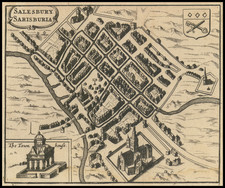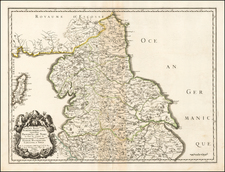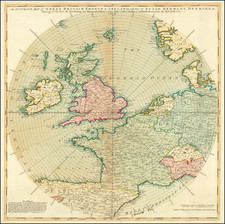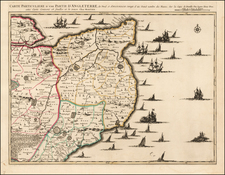This engraving of the gardens and buildings of Wrest Park, the seat of the Duke of Kent, in Bedfordshire, England was executed by John Rocque in 1737.
Wrest Park is known for its extensive formal gardens and magnificent architecture, reflecting the grandeur and landscaping principles of the 18th century. The estate has been a significant site in British history, renowned for its elaborate gardens designed to complement the stately mansion at its center
Rocque's work provides a detailed depiction of the estate's layout and architectural features. Dedicated to the Duke of Kent, Rocque's engraving of the intricate design and grandeur of the garden and its accompanying structures.
During the 18th century, the English landscape garden emerged as a significant cultural and aesthetic development, influenced by a combination of Enlightenment ideals and a desire for naturalistic beauty. John Rocque, a prominent cartographer and surveyor, is renowned for his detailed engravings and maps that reflect the era's emphasis on meticulous planning and artistic representation of landscapes. This particular plan of the Duke of Kent's estate exemplifies the fusion of geometric precision and aesthetic sophistication that characterized the period.
The central feature of the plan is the expansive garden, meticulously laid out with intersecting paths, ornamental trees, and various formal elements that underscore the period's landscaping principles. The garden's design includes a series of symmetrical parterres, serpentine walkways, and strategically placed statuary, illustrating a balance between natural beauty and human artistry.
The plan is adorned with multiple insets showcasing the estate's prominent buildings and structures:
- The Mansion House - Positioned centrally, it serves as the focal point of the estate, symbolizing the Duke's status and the architectural grandeur of the period.
- The Dome and Obelisk - These classical elements add an air of antiquity and grandeur, aligning with the Enlightenment's fascination with classical antiquity.
- The Garden Pavilions - Strategically placed throughout the garden, these structures provide focal points and enhance the aesthetic symmetry of the landscape.
- The Statues and Columns - Scattered throughout the estate, they contribute to the garden's decorative appeal and underscore the influence of classical motifs.
John Rocque (circa 1704-1762), an 18th-century surveyor of Huguenot descent, left a profound imprint on the topographical representation of England, particularly through his elaborate maps of London and its surroundings. Despite his significant contributions, his life, both personally and professionally, remains somewhat cloaked in mystery.
Born likely around 1704 or 1705 to French Huguenot parents who migrated to Geneva following the revocation of the Edict of Nantes, Rocque found his calling in England. There, he and his siblings were known to have spent significant parts of their lives. His journey into surveying took off in 1734, with his first recognized work involving a survey of Richmond House and its gardens. This engagement emerged at a fortuitous time when the landscaping and design of the nobility's estates were witnessing renewed interest, which required accurate surveying—a skill Rocque exemplified.
Rocque didn't confine his talents to surveying alone but ventured into printselling, owning a shop near Hyde Park Corner by 1743. This enterprise reflected his energetic nature and the breadth of his ambition, contributing to his reputation for high-quality work, evidenced by the size of his workforce, which included up to ten draughtsmen and engravers at times.
In his later years, Rocque faced adversity, with his shop and entire stock in Whitehall being devastated by fire in 1750. However, his resilience saw him bounce back, and despite several relocations, Rocque maintained his business operations around the Strand area. By the 1750s, his work had taken him to Dublin, where he made substantial contributions in the form of numerous Irish maps and various English county maps.
On the personal front, Rocque married twice but had no known children from either marriage. His first wife was Marthe, whom he married by 1728, and following her death, he married Mary Anne Bew in 1751. Rocque's health began deteriorating towards the end of his life, leading to his death on January 27, 1762. His widow, Mary Anne, continued to manage the business for several years after his demise.











![[London to Sheppey Island / Great Yarmouthand environs] Afteekening van de Rivier van London of River Thames / Afteekening van de Tarmouthse Banken geleegen voor Iarmouth Aan de Oost](https://storage.googleapis.com/raremaps/img/small/85128.jpg)


![[ Genealogy of the English Monarchy ] Reges Angliae Inclijto ac Potentiss](https://storage.googleapis.com/raremaps/img/small/99752.jpg)